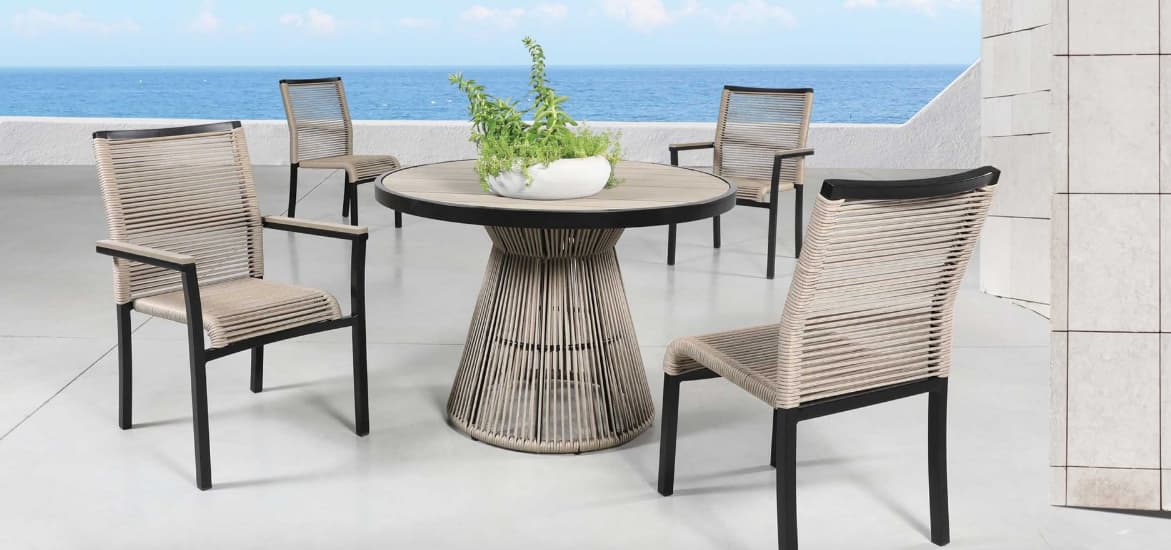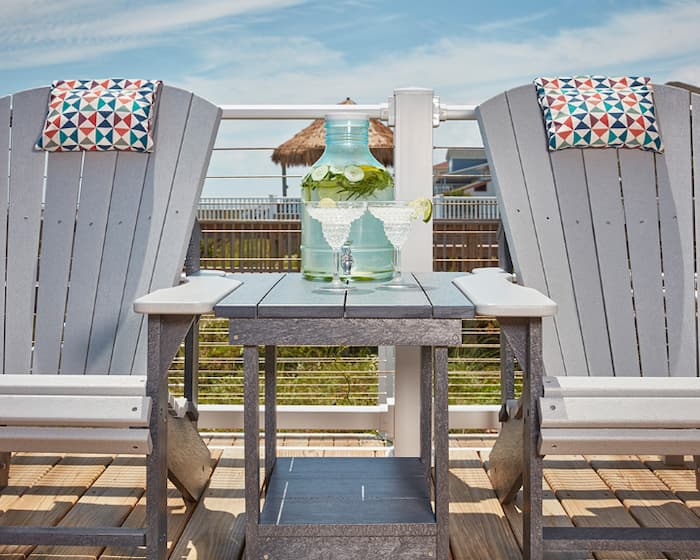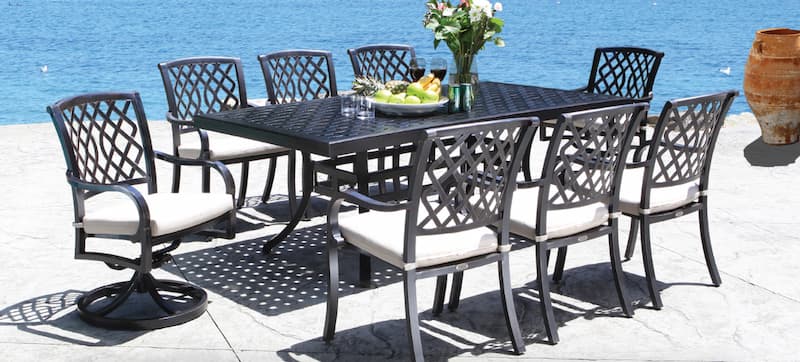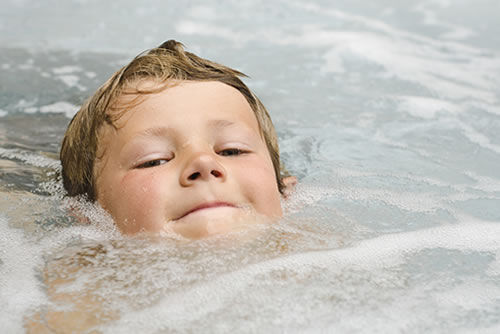If you’ve watched Game Of Thrones from beginning to end, every time the fall season rolls around you might hear a soft voice that gently whispers, “Winter is coming…!” For most of us (and John Snow), this means getting ready to protect the things that may be destroyed from the winter climate. If you’ve already purchased patio furniture with us then you already know you have an investment worth protecting. So read on and let us tell you what to do with patio furniture in the winter.
The extra time and care you take in preparing your outdoor furniture for the first snowfall makes a difference in how long your furniture lasts and for how long it looks like new. Make sure you know exactly what type of material you have so you know what to do with patio furniture in the winter.
Protecting patio furniture in winter
The truth is, there are many different options when it comes to how you protect your furniture. In a perfect world with maximum protection from winter, you would 1) clean 2) cover) and put your outdoor furniture in storage (pending any treatments and coats required). This would be the pinnacle of preservation for any outdoor patio set you own.
But is all this absolutely necessary?!
Not all of it-but some steps definitely need to be followed.
Depending on the type of material you have will depend on what you can get away with in terms of winter protection. Storing your outdoor furniture indoors isn’t an option for some people. Here are some tips on what to do with patio furniture in the winter depending on what material you own.
Can you leave wicker furniture outside during the winter?
If you’ve been reading our blog, you would know that wicker patio furniture refers to the style (woven) and not the actual material. Wicker patio furniture was originally made with rattan, a soft vine-like wood, which is not particularly weather-resistant when it comes to rain, snow and ice. You will need to store natural rattan furniture (and most softwood furniture) in a dry space indoors.
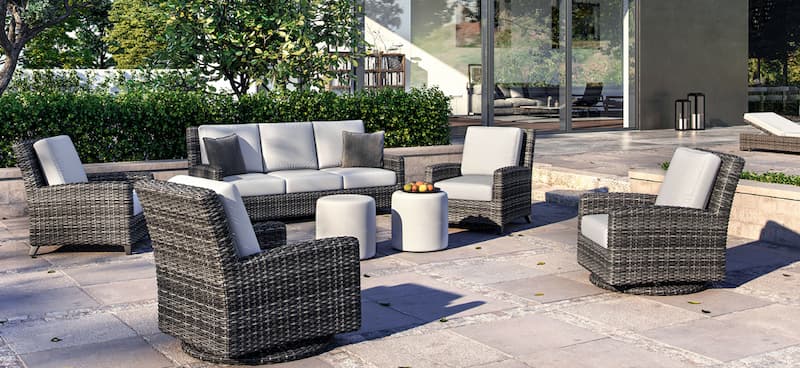
Synthetic wicker furniture can be left outside all year long. SolWeave Outdoor Wicker is Cabana Coasts’ flagship material that is made with resin wicker and is designed to withstand the elements. It won’t hurt to throw some furniture covers overtop to preserve the newness and longevity. Without them, you might see premature cracking and fading.
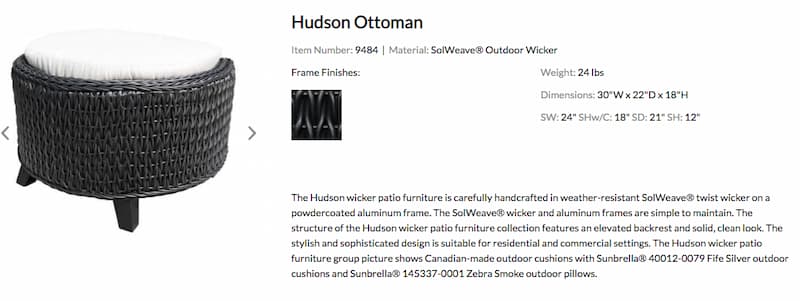
Protect natural materials during winter
Teak is the most durable type of wood and is well-known for its resistance to the elements. It’s one of one the only types of wood that has a natural oil that repels water and makes it perfect for outdoor furniture.
Grade A teak is the wood that’s found closest to the center of the tree and therefore has the tightest grains and largest oil content. There is of course grade B and grade C teak, which if you haven’t guessed already is less durable, making it more susceptible to the elements.
Regardless of what type of natural wood your furniture is made from, you will need to do some upkeep and protect it before winter sets in. Manufacturers recommend a good cleaning and an application of specialty oil (for teak) and acrylic coats (for other types of wood) to maintain and protect your investment.
Plastic outdoor furniture
Despite its ability to go the distance in durability, recycled plastic furniture must be kept indoors during the winter. The cold to plastic is what kryptonite is to superman. The freezing temperatures will cause the plastic to become brittle and break.
Clean your outdoor plastic furniture with a hose. Give it a good towel-dry and get them safely indoors for the colder months ahead.
Should outdoor metal furniture be stored inside for the winter?
Not all metal is created equal. Wrought iron, for example, is susceptible to rust. It’s crucial to scrub off any rust with a wire brush at the earliest signs as well as before the winter months set in. Spray with a paint that is used specifically for wrought iron to give it an added layer of protection.
That being said, metal furniture doesn’t necessarily need to be brought inside. Wrought iron is extremely heavy and it can survive winters with a furniture cover or tarp and the proper preventative maintenance.
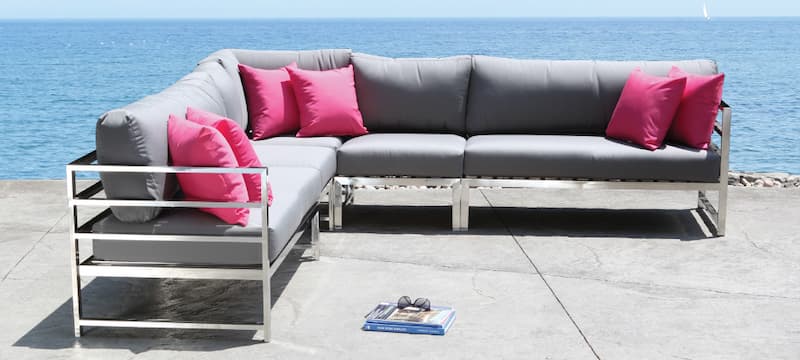
While steel on its own can also fall victim to rust, most outdoor furniture is made with either stainless steel, powder-coated reinforced steel to prevent rusting. The furniture with the best type of winter protection is hot-dip galvanized steel. This type of furniture has been bathed in hot zinc to form an effective weather barrier and is considered the most ideal material of the furniture you can leave outdoors for the winter.
Lastly, Aluminum is also one of the best types of outdoor furniture for surviving the harsh winter climate. Aluminum outdoor furniture is powder coated and rustproof. Plus, it doesn’t expand and weaken as steel does.
Aluminum is very low-maintenance and only requires cleaning and perhaps some touch-up paint wherever it is needed. As mentioned before, it can stay outside but a furniture cover and tarp will help maintain the shine and extend the life of your patio set.
Can you leave a glass patio table outdoors during the winter?
Whether your table (tabletop) is made from glass or tempered glass (like most outdoor patio tables) you should store it in a safe place indoors. The truth is although tempered glass is much stronger than glass, it’s still not indestructible and should be stored inside.
Extreme cold makes the glass more susceptible to cracking. If your glass patio table gets hit with any falling debris (ice, snow, hail) it could spell disaster and the end of its life. Just to be safe, store your glass in a safe, out-of-the-way place (where no one will knock it down) indoors.
How to store outdoor cushions for the winter
No matter whether your cushions are removable or not, you will need to clean them before winter. Brush them off to remove some of the larger debris and dirt that they’ve collected over the warmer months.
If you can remove the covers, wash and dry them according to the manufacturer’s recommendations.
If there’s the slightest hint of mildew from the summer months make sure you use a mix of bleach in your cleaning solution (if the situation allows-check the tags!). A mixture of soap and white vinegar can also be used to kill the bacteria.
Whether they can go in the dryer or not-air drying is the best option. A complete air dry prevents the seams from cracking, plus you preserve the colour of your fabric.
Cushions must be completely dry before storing away in your shed, basement or under the furniture cover. Mildew is the last thing you want growing because of any remaining moisture.
Furniture covers, tarps and storage
The last thing you need to remember is that if protecting your patio furniture is high on your priority list, the best thing you can do is keep it covered and stored. Follow our general guidelines on what to do with patio furniture in the winter so that when winter comes-you’ll be ready and waiting!
Even though most patio furniture is made to be outdoors during the winter, it doesn’t mean the winter months won’t add wear and tear to your beloved patio set. Keep your outdoor furniture clean, covered and properly maintained to get years of life from your investment.
For any questions about what to do for your outdoor furniture set, give us a call or visit our showroom and we’ll be glad to help you any way we can.

